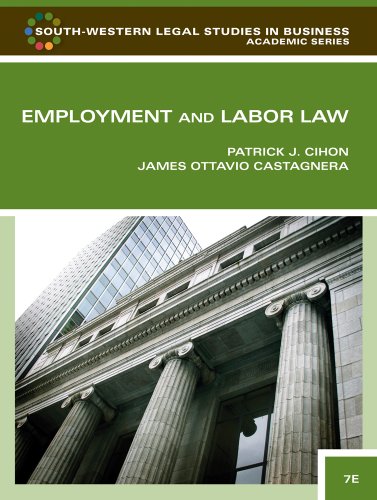On February 23, 1983, Gerald Forrest, a union member, addressed to Carroll Koepplinger, president of the defendant
Question:
On February 23, 1983, Gerald Forrest, a union member, addressed to Carroll Koepplinger, president of the defendant union, a letter setting forth the basis of his objections to the December 1982 election. The local received Forrest’s letter and filed it. Forrest did not receive a response from the union, and pursuant to the LMRDA, he thereafter filed a timely complaint with the U.S. Department of Labor. The Department of Labor conducted an investigation of the allegations of Forrest’s complaint and found probable cause to believe that violations of Title IV had occurred.
At the time of the election, 378 members belonged to the local. They were employed by approximately eighteen employers spread geographically in the states of Illinois and Iowa. Eight separate nomination meetings were held and were generally conducted by Koepplinger. Following the nomination meetings, the Local 518 secretary reviewed the list of the nominees to determine the eligibility of each in accordance with the union requirements. One of those requirements was that no member could be nominated to any office unless the individual had been a member of the local or international union continuously for five years immediately preceding his or her nomination. As a result of that requirement, four nominees were ruled ineligible to run for office.
The shop stewards distributed the ballots to union members in their shops while the members were working. The instruction sheet did not contain any instructions for shop stewards with respect to the procedure to be followed in issuing ballots. At least two of the shop stewards who distributed ballots were themselves candidates for union office (one of the two was unopposed). After collecting all the voted ballots, the stewards returned the package to the secretary of the local. The voted ballots were stored in an unlocked filing cabinet in the union hall. The secretary took leave of absence from the local from approximately December 23, 1982, to January 3, 1983, during which time Koepplinger had sole responsibility for the conduct of the election.
Koepplinger selected December 30, 10:00 A.M., to tally the ballots. Koepplinger was present at the local union hall during the tally but in a different room from where the tally took place. The candidates were not affirmatively advised of the time and place of the election tally, and no observers were present. It is unclear whether any candidates had actual notice of the counting. The court requested affidavits from the parties on this question. Only the plaintiff filed affidavits. Those affidavits state that the affiants were never advised of the tally by anyone from the local.
They do not answer the question of whether actual notice occurred.
The referendum committee that counted the ballots did not count or reconcile the number of unused ballots and the number of voted ballots to account for all of the official printed ballots. After the election, the local maintained all the election records except for the unvoted ballots. Koepplinger threw these away approximately three weeks after the election tally as part of an office cleanup.
According to the election records, there were 328 voted ballots. There were fifteen elected officers, of which three were contested races.
Should the court overturn this election? See Donovan v. Graphic Arts Union [118 L.R.R.M. 2093
(C.D. Ill. 1984)].
Step by Step Answer:

Employment And Labor Law
ISBN: 9781439037270
7th Edition
Authors: Patrick J. Cihon , James Ottavio Castagnera





